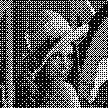Graphic/Image Data Structures
Standard System Independent Formats
Specific System Dependent Formats

This section introduces some of the most common graphics and image file
formats. Some of them are restricted to
particular hardware/operating system platforms, others are
cross-platform independent formats.
While not all formats are cross-platform, there are conversion
applications that will recognize and translate formats from
other systems.
Most image formats incorporate some variation of a compression
technique due to the large storage size of image files.
Compression techniques can be classified into either lossless
or lossy. We will study various video and audio
compression techniques in Chapter 4.
- Pixels -- picture elements in digital images
- Image Resolution -- number of pixels in a digital image
(Higher resolution always yields better quality.)
- Bit-Map -- a representation for the graphic/image data
in the same manner as they are stored in video memory.
Monochrome Image

Example of a Monochrome Bit-map Image
- Each pixel is stored as a single bit (0 or 1)
- A 640 x 480 monochrome image requires 37.5 KB of storage.
- Dithering is often used for displaying monochrome images
Gray-scale Images

Example of a Gray-scale Bit-map Image
- Each pixel is usually stored as a byte (value between 0 to 255)
- A 640 x 480 grayscale image requires over 300 KB of storage.
24-bit Color Images

Example of 24-Bit Color Image
- Each pixel is represented by three bytes (e.g., RGB)
- Supports 256 x 256 x 256 possible combined colors (16,777,216)
- A 640 x 480 24-bit color image would require 921.6 KB of storage
- Many 24-bit color images are stored as 32-bit images, the extra
byte of data for each pixel is used to store an alpha value
representing special effect information
8-bit Color Images

Example of 8-Bit Color Image
- One byte for each pixel
- Supports 256 out of the millions colors possible,
acceptable color quality
- Requires Color Look-Up Tables (LUTs)
- A 640 x 480 8-bit color image requires 307.2 KB of storage
(the same as 8-bit grayscale)
The following brief format descriptions are the most commonly used
formats. Follow some of the document links for more descriptions.
- Graphics Interchange Format (GIF)
devised by the UNISYS Corp. and Compuserve, initially for transmitting
graphical images over phone lines via modems
- Uses the Lempel-Ziv Welch algorithm (a form of Huffman Coding),
modified slightly for image scan line packets (line grouping of pixels)
- Limited to only 8-bit (256) color images, suitable for images
with few distinctive colors (e.g., graphics drawing)
- Supports interlacing
- GIF89a supports simple animation
(Graphics Control Extension has control over
delay time, transparent index, etc. Software such
as Coral Draw will allow access and editing of GIF images.)
- A standard for photographic image compression created by the
Joint Photographics Experts Group
- Takes advantage of limitations in the human vision system to
achieve high rates of compression
- Lossy compression which allows user to set the desired level of
quality/compression
- Detailed discussions in Chapter 4.
TIFF
- Tagged Image File Format (TIFF), stores
many different types of images (e.g., monochrome, grayscale,
8-bit & 24-bit RGB, etc.) --> tagged
- Developed by the Aldus Corp. in the 1980's and later
supported by Microsoft.
- TIFF is a lossless format (when not utilizing the new JPEG tag
which allows for JPEG compression).
- It does not provide any major advantages over JPEG and is not
as user-controllable it appears to be declining in popularity.
Graphics Animation Files
- FLC -- main animation or moving picture file format, originally
created by Animation Pro
- FLI -- similar to FLC
- GL -- better quality moving pictures, usually large file sizes
Postscript/Encapsulated Postscript
- A typesetting language which includes text as well as
vector/structured graphics and bit-mapped images
- Used in several popular graphics programs (Illustrator, FreeHand)
- Does not provide compression, files are often large
Many graphical/imaging applications create their own file format
particular to the systems they are executed upon.
The following are a few popular system dependent formats:
Microsoft Windows: BMP
- A system standard graphics file format for Microsoft Windows
- Used in PC Paintbrush and other programs
- It is capable of storing 24-bit bitmap images
Macintosh: PAINT and PICT
- PAINT was originally used in MacPaint program, initially only for
1-bit monochrome images.
- PICT format is used in MacDraw (a vector based drawing program)
for storing structured graphics
X-windows: XBM
- Primary graphics format for the X Window system
- Supports 24-bit color bitmap
- Many public domain graphic editors, e.g., xv
- Used in X Windows for storing icons, pixmaps, backdrops, etc.
Further Exploration 
 A new graphics file format -- PNG (Portable Network Graphics)
A new graphics file format -- PNG (Portable Network Graphics)
 Current PNG References
Current PNG References
 Animated illustration of the PNG 2-D interlacing
Animated illustration of the PNG 2-D interlacing
Top |
Chap3 |
CMPT 365 Home Page |
CS




![]() Animated illustration of the PNG 2-D interlacing
Animated illustration of the PNG 2-D interlacing